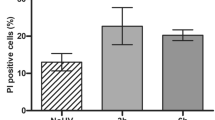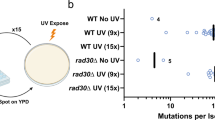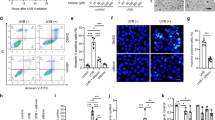Abstract
Ultraviolet (UV) light exposure is a common cause of epithelial-derived skin cancers, and the epidermal response to UV-light has been extensively studied using both mouse models and cultured human keratinocytes (KCs). Elimination of cells with UV-induced DNA damage via apoptosis provides a powerful mechanism to minimize retention or expansion of genetically abnormal cells. This cell editing function has largely been ascribed to the biological role of the p53 tumor suppressor gene, as mutations or deletions involving p53 have been linked to skin cancer development. Rather than introducing mutations, or using cells with complete loss of wild-type p53, we used an siRNA-based approach to knockdown, but not eliminate, p53 levels in primary cultures of human KCs followed by UV-irradiation. Surprisingly, when p53 levels were reduced by 50–80% the apoptosis induced by exposure to UV-light was accelerated and markedly enhanced (two- to three- fold) compared to control siRNA treated KCs. The p53 siRNA treated KCs were characterized by elevated E2F-1 levels accompanied by accelerated elimination of the Mcl-1 and Bcl-xL antiapoptotic proteins, as well as enhanced Bax oligomerization. Forced overexpression of either Mcl-1 or Bcl-xL reduced the UV-light enhanced apoptotic response in p53 siRNA treated KCs. We conclude that p53 not only can provide proapoptotic signals but also regulates a survival pathway influencing Mcl-1 and Bcl-xL levels. This overlooked survival function of p53 may explain previous paradoxical responses noted by investigators using p53 heterozygous and knockout mouse models, and opens up the possibility that not all liaisons within the cell involving p53 necessarily represent fatal attractions.
This is a preview of subscription content, access via your institution
Access options
Subscribe to this journal
Receive 50 print issues and online access
$259.00 per year
only $5.18 per issue
Buy this article
- Purchase on Springer Link
- Instant access to full article PDF
Prices may be subject to local taxes which are calculated during checkout








Similar content being viewed by others
References
Alani RM, Hasskarl J, Grace M, Hernandez MC, Israel MA and Munger K . (1999). Proc. Natl. Acad. Sci. USA, 96, 9637–9641.
Ananthaswamy HN, Loughlin SM, Cox P, Evans RL, Ullrich SE and Kripke ML . (1997). Nat. Med., 3, 510–514.
Bolshakov S, Walker CM, Strom SS, Selvan MS, Clayman GL, El-Naggar A, Lippman SM, Kripke ML and Ananthaswamy HN . (2003). Clin. Cancer Res., 9, 228–234.
Bowden GT . (2004). Nat. Rev. Cancer, 4, 23–35.
Brash DE, Rudolph JA, Simon JA, Lin A, McKenna GJ, Baden HP, Halperin AJ and Ponten J . (1991). Proc. Natl. Acad. Sci. USA, 88, 10124–10128.
Brummelkamp TR, Bernards R and Agami R . (2002). Science, 296, 550–553.
Bykov VJ, Issaeva N, Shilov A, Hultcrantz M, Pugacheva E, Chumakov P, Bergman J, Wiman KG and Selivanova G . (2002). Nat. Med., 8, 282–288.
Campisi J . (2004). Nat. Med., 10, 231–232.
Chaturvedi V, Bacon P, Bodner B and Nickoloff BJ . (2004). J. Invest. Dermatol., 123, 1200–1203.
Chaturvedi V, Qin JZ, Denning MF, Choubey D, Diaz MO and Nickoloff BJ . (1999). J. Biol. Chem., 274, 23358–23367.
Chaturvedi V, Qin JZ, Denning MF, Choubey D, Diaz MO and Nickoloff BJ . (2001). J. Dermatol. Sci., 26, 67–78.
Chipuk JE, Kuwana T, Bouchier-Hayes L, Droin NM, Newmeyer DD, Schuler M and Green DR . (2004). Science, 303, 1010–1014.
Croxton R, Ma Y, Song L, Haura EB and Cress WD . (2002). Oncogene, 21, 1359–1369.
Dick FA and Dyson N . (2003). Mol. Cell, 12, 639–649.
Evan GI, Wyllie AH, Gilbert CS, Littlewood TD, Land H, Brooks M, Waters CM, Penn LZ and Hancock DC . (1992). Cell, 69, 119–128.
Finlay CA, Hinds PW and Levine AJ . (1989). Cell, 57, 1083–1093.
Foster BA, Coffey HA, Morin MJ and Rastinejad F . (1999). Science, 286, 2507–2510.
Fridman JS and Lowe SW . (2003). Oncogene, 22, 9030–9040.
Friedler A, Hansson LO, Veprintsev DB, Freund SM, Rippin TM, Nikolova PV, Proctor MR, Rudiger S and Fersht AR . (2002). Proc. Natl. Acad. Sci. USA, 99, 937–942.
Greenhalgh DA, Wang XJ, Donehower LA and Roop DR . (1996). Cancer Res., 56, 4413–4423.
Hanahan D and Weinberg RA . (2000). Cell, 100, 57–70.
Hawkins DS, Demers GW and Galloway DA . (1996). Cancer Res., 56, 892–898.
Honeycutt KA, Koster MI and Roop DR . (2004). J. Invest. Dermatol. Symp. Proc., 9, 261–268.
Iglesias-Serret D, Pique M, Gil J, Pons G and Lopez JM . (2003). Arch. Biochem. Biophys., 417, 141–152.
Jackson S, Harwood C, Thomas M, Banks L and Storey A . (2000). Genes Dev., 14, 3065–3073.
Jiang W, Ananthaswamy HN, Muller HK and Kripke ML . (1999). Oncogene, 18, 4247–4253.
Jourdan M, Veyrune JL, Vos JD, Redal N, Couderc G and Klein B . (2003). Oncogene, 22, 2950–2959.
Kemp CJ, Donehower LA, Bradley A and Balmain A . (1993). Cell, 74, 813–822.
Knezevic D and Brash DE . (2004). Cell Cycle, 3, 729–732.
Lee S, Elenbaas B, Levine A and Griffith J . (1995). Cell, 81, 1013–1020.
Leffell DJ and Brash DE . (1996). Sci. Am., 275, 52–59.
Leu JI, Dumont P, Hafey M, Murphy ME and George DL . (2004). Nat. Cell Biol., 6, 443–450.
Levine AJ . (1997). Cell, 88, 323–331.
Maeda T, Hanna AN, Sim AB, Chua PP, Chong MT and Tron VA . (2002). J. Invest. Dermatol., 119, 22–26.
Malkin D, Li FP, Strong LC, Fraumeni Jr JF, Nelson CE, Kim DH, Kassel J, Gryka MA, Bischoff FZ and Tainsky MA . (1990). Science, 250, 1233–1238.
Martinou JC and Green DR . (2001). Nat. Rev. Mol. Cell Biol., 2, 63–67.
McKay BC, Chen F, Perumalswami CR, Zhang F and Ljungman M . (2000). Mol. Biol. Cell, 11, 2543–2551.
McKay BC and Ljungman M . (1999). Neoplasia, 1, 276–284.
Mihara M, Erster S, Zaika A, Petrenko O, Chittenden T, Pancoska P and Moll UM . (2003). Mol. Cell, 11, 577–590.
Mikhailov V, Mikhailova M, Degenhardt K, Venkatachalam MA, White E and Saikumar P . (2003). J. Biol. Chem., 278, 5367–5376.
Nakazawa H, English D, Randell PL, Nakazawa K, Martel N, Armstrong BK and Yamasaki H . (1994). Proc. Natl. Acad. Sci. USA, 91, 360–364.
Nelson MA, Einspahr JG, Alberts DS, Balfour CA, Wymer JA, Welch KL, Salasche SJ, Bangert JL, Grogan TM and Bozzo PO . (1994). Cancer Lett., 85, 23–29.
Nickoloff BJ, Chaturvedi V, Bacon P, Qin JZ, Denning MF and Diaz MO . (2000). J. Biol. Chem., 275, 27501–27504.
Nickoloff BJ, Qin JZ, Chaturvedi V, Bacon P, Panella J and Denning MF . (2002). J. Invest. Dermatol. Symp. Proc., 7, 27–35.
Nijhawan D, Fang M, Traer E, Zhong Q, Gao W, Du F and Wang X . (2003). Genes. Dev., 17, 1475–1486.
Ouhtit A, Nakazawa H, Armstrong BK, Kricker A, Tan E, Yamasaki H and English DR . (1998). J. Natl. Cancer Inst., 90, 523–531.
van Oosten M, Stout GJ, Backendorf C, Rebel H, de Wind N, Darroudi F, van Kranen HJ, de Gruijl FR and Mullenders LH . (2005). DNA Repair (Amst.), 4, 81–89.
Perfettini JL, Kroemer RT and Kroemer G . (2004). Nat. Cell Biol., 6, 386–388.
Qin JZ, Bacon P, Panella J, Sitailo LA, Denning MF and Nickoloff BJ . (2004). J. Cell Physiol., 200, 155–166.
Qin JZ, Chaturvedi V, Denning MF, Bacon P, Panella J, Choubey D and Nickoloff BJ . (2002). Oncogene, 21, 2991–3002.
Rambhatla L, Bohn SA, Stadler PB, Boyd JT, Coss RA and Sherley JL . (2001). J. Biomed. Biotechnol., 1, 28–37.
Reed M, Woelker B, Wang P, Wang Y, Anderson ME and Tegtmeyer P . (1995). Proc. Natl. Acad. Sci. USA, 92, 9455–9459.
Rheinwald JG, Hahn WC, Ramsey MR, Wu JY, Guo Z, Tsao H, De Luca M, Catricala C and O'Toole KM . (2002). Mol. Cell Biol., 22, 5157–5172.
Sherr CJ . (2004). Cell, 116, 235–246.
Sitailo LA, Tibudan SS and Denning MF . (2004). J. Invest. Dermatol., 123, 434–443.
Tsai KY and Tsao H . (2004). Am. J. Med. Genet., 131C, 82–92.
Tudor D, Locke M, Owen-Jones E and Mackenzie IC . (2004). J. Invest. Dermatol. Symp. Proc., 9, 208–214.
Tyner SD, Venkatachalam S, Choi J, Jones S, Ghebranious N, Igelmann H, Lu X, Soron G, Cooper B, Brayton C, Hee PS, Thompson T, Karsenty G, Bradley A and Donehower LA . (2002). Nature, 415, 45–53.
Vousden KH . (2000). Cell, 103, 691–694.
Vousden KH and Lu X . (2002). Nat. Rev. Cancer, 2, 594–604.
Wahl AF, Donaldson KL, Fairchild C, Lee FY, Foster SA, Demers GW and Galloway DA . (1996). Nat. Med., 2, 72–79.
Wang Y, Engels IH, Knee DA, Nasoff M, Deveraux QL and Quon KC . (2004). Cancer Cell, 5, 501–512.
Weinberg WC, Azzoli CG, Kadiwar N and Yuspa SH . (1994). Cancer Res., 54, 5584–5592.
Zhang W, Hanks AN, Boucher K, Florell SR, Allen SM, Alexander A, Brash DE and Grossman D . (2005). Carcinogenesis, 26, 249–257.
Zhao R, Gish K, Murphy M, Yin Y, Notterman D, Hoffman WH, Tom E, Mack DH and Levine AJ . (2000). Genes Dev., 14, 981–993.
Ziegler A, Jonason AS, Leffell DJ, Simon JA, Sharma HW, Kimmelman J, Remington L, Jacks T and Brash DE . (1994). Nature, 372, 773–776.
Acknowledgements
We thank Drs Divaker Choubey and Brian Bonish for their valuable assistance with this work, and Ms Lynn Walter for preparing the text and figures. This work was supported by NIH grants CA 83784 (MFD) and AR 47814 and AR 47307 (BJN).
Author information
Authors and Affiliations
Corresponding author
Rights and permissions
About this article
Cite this article
Chaturvedi, V., Sitailo, L., Qin, JZ. et al. Knockdown of p53 levels in human keratinocytes accelerates Mcl-1 and Bcl-xL reduction thereby enhancing UV-light induced apoptosis. Oncogene 24, 5299–5312 (2005). https://doi.org/10.1038/sj.onc.1208650
Received:
Revised:
Accepted:
Published:
Issue Date:
DOI: https://doi.org/10.1038/sj.onc.1208650
Keywords
This article is cited by
-
Computational modeling of DLBCL predicts response to BH3-mimetics
npj Systems Biology and Applications (2023)
-
p53-dependent regulation of Mcl-1 contributes to synergistic cell death by ionizing radiation and the Bcl-2/Bcl-XL inhibitor ABT-737
Apoptosis (2012)
-
P53 in human melanoma fails to regulate target genes associated with apoptosis and the cell cycle and may contribute to proliferation
BMC Cancer (2011)
-
Potent inhibition of rhabdoid tumor cells by combination of flavopiridol and 4OH-tamoxifen
BMC Cancer (2010)
-
A p38MAPK/HIF-1 Pathway Initiated by UVB Irradiation Is Required to Induce Noxa and Apoptosis of Human Keratinocytes
Journal of Investigative Dermatology (2010)



